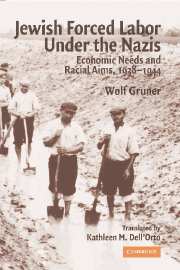Book contents
- Frontmatter
- Contents
- Abbreviations
- Introduction
- Prologue: Anti-Jewish Policies in the Nazi State before 1938
- GERMANY
- AUSTRIA
- THE PROTECTORATE OF BOHEMIA AND MORAVIA
- THE OCCUPIED TERRITORIES OF POLAND
- 6 Camps and Ghettos – Forced Labor in the Reich Gau Wartheland, 1939–1944
- 7 On the “Führer's Road” – Polish Jews in Germany, 1940–1943
- 8 The SS Organisation Schmelt and the Jews from Eastern Upper Silesia, 1940–1944
- 9 The Labor Office versus the SS – Forced Labor in the General Government, 1939–1944
- Conclusion
- Index of Subjects
- Index of Persons
- Index of Places and Camps
7 - On the “Führer's Road” – Polish Jews in Germany, 1940–1943
Published online by Cambridge University Press: 05 June 2012
- Frontmatter
- Contents
- Abbreviations
- Introduction
- Prologue: Anti-Jewish Policies in the Nazi State before 1938
- GERMANY
- AUSTRIA
- THE PROTECTORATE OF BOHEMIA AND MORAVIA
- THE OCCUPIED TERRITORIES OF POLAND
- 6 Camps and Ghettos – Forced Labor in the Reich Gau Wartheland, 1939–1944
- 7 On the “Führer's Road” – Polish Jews in Germany, 1940–1943
- 8 The SS Organisation Schmelt and the Jews from Eastern Upper Silesia, 1940–1944
- 9 The Labor Office versus the SS – Forced Labor in the General Government, 1939–1944
- Conclusion
- Index of Subjects
- Index of Persons
- Index of Places and Camps
Summary
TEN THOUSAND GERMAN JEWS FOR THE AUTOBAHN: A PLAN OF THE SS AND FRITZ TODT
In mid-October 1940, Arthur Greiser, the Reichsstatthalter in Posen, announced to journalists that he “had received permission to construct a Reich Autobahn from Frankfurt an der Oder to Posen that would provide work for a large number of unemployed Warthegau Jews.” Against the background of years-long persecution of Jews on the one hand, and on the other the forced labor introduced since the beginning of the war in the occupied Polish territories for the Jews living there, this announcement of a special forced-labor project to develop the east–west connection critical to the war was nothing spectacular. Buried in this news, however, was an ideologically explosive problem: Part of the stretch of road was located on Old Reich territory, the region that all the efforts of the National Socialists had sought since 1933 to “cleanse” of Jews – whatever their nationality. From the Nazi perspective, establishing dozens of labor camps for Polish Jews in this sector was out of the question.
The responsible officials therefore initially intended to employ German Jewish forced laborers for this segment. For this, they actually could have relied on the help of the Reich labor administration, which had been arranging segregated labor deployment since the beginning of 1939. Nevertheless, the General Inspector for the German Roadway System (Generalinspektor für das Deutsche Straßenwesen, or GIS), Fritz Todt, at the beginning of October 1940 pressed the Reich Security Main Office (RSHA), not the labor administration, to supply laborers quickly to the highway construction sites important for the war.
- Type
- Chapter
- Information
- Jewish Forced Labor under the NazisEconomic Needs and Racial Aims, 1938–1944, pp. 196 - 213Publisher: Cambridge University PressPrint publication year: 2006

